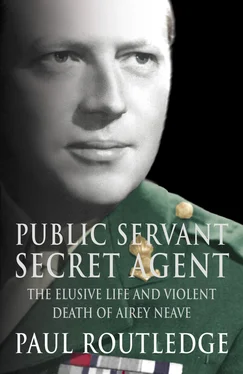Two nights a week, Neave toiled flat on his stomach, a handkerchief over his mouth to keep out the choking dust. Disposal of the debris was the most difficult thing for most of the obvious hiding places had already been bagged by other tunnellers. Neave and his crew stored great piles of dust and stones in the loft of the building, which eventually gave way, breaking a water pipe that showered French prisoners as they slept. While he worked away at this forlorn occupation, Neave continued to develop his own project. Through their ‘goon watch’, the prisoners knew all about the movement of German personnel throughout the castle. They now learned that everyone who entered the inner courtyard that housed the prisoners had to collect a numbered brass disc at the guardhouse, present it to the sentry on the inner gate, and return it to the guardhouse. Peter Allan, a second lieutenant in the Cameron Highlanders, bribed a visiting civilian painter to part with his brass pass, which went into the British cache of escaping material. However, the workman was obliged to report his ‘loss’, and the German officers warned their guards to be on the lookout for the missing disc.
Most importantly, Neave had to fashion for himself a ‘German’ military uniform that would be sufficiently convincing to get him past the guards. He had also to equip himself with civilian clothes capable of sustaining his disguise as a foreign worker all the way to Switzerland, the nearest neutral country 400 miles to the south. He thought first of bribing the very German guards he was attempting to fool to acquire a complete uniform, but he concluded that this might take years, and he was impatient to be free. So he resolved to make his own, despite admitting that he was hopeless with his hands.
Neave sacrificed a month’s supply of Red Cross chocolate to buy from a Polish officer what he later described as ‘an ancient tunic … in a remote sort of way it resembled in length and design that worn by German private soldiers’. It was the wrong colour – khaki rather than field-grey – and although he contemplated dyeing the tunic, this was beyond him. Instead he employed less subtle means: he applied layers of green paint normally used for making the scenery in the camp theatre. A Polish tailor sewed fake insignia, fashioned from cardboard and painted silver, on to the left breast. Dark green cloth epaulettes with the white numerals of an infantry regiment, a forage cap fashioned from a piece of Polish uniform, white piping and an amateurish cardboard badge with eagle’s wings completed this improbable disguise. He planned to wear RAF trousers for the escape, and lastly equipped himself with a pair of handsome jackboots bought from a Polish orderly with Red Cross provisions. Neave realised that his mock uniform would never pass muster in daylight. Even with the precious brass disc, he would have to pass through three sentry posts, and might also meet other soldiers who would see through his disguise.
Ellison Platt, the Methodist chaplain, noted in his prison diary for 28 August: ‘For weeks Anthony Neave has had no thought for anything but tailoring and dyeing.’ (After his first diary entry for 14 May, in which he uses Neave’s correct first name, Platt invariably wrote ‘Anthony’, a clear indication that this was how Neave was known, and wished to be known, in the camp.) Platt observed that Neave’s scheme was one of great audacity, adding: ‘It consisted of passing out of the main gates in the uniform of a German soldier. Since the time the maggot first entered his brain, every minute has been dedicated to “getting ready”.’ His first idea was to steal a uniform, which might be done ‘at a pinch’, but could prove very unpleasant if caught in an abortive escape. ‘So, on reflection, it would be better to take the long route and make it: during the period of making, nothing else has existed in the world. With an unethical fertility of invention he got hold of a mixture of several incredible substances which produce a lightish green field if applied to a khaki material.’ Not quite near enough for daylight, but, under artificial light, quite indistinguishable from the real thing, he noted. ‘The dyeing experiments have occupied a full three weeks.’ His swastikas, woven on tunic and hat, were extraordinarily well done, as was the belt, ‘a creation in tin and cardboard that deserved a better fate’. 9
Neave was less convinced, later admitting: ‘I was only too aware of the fancy-dress appearance of my uniform, fit only for amateur theatricals,’ he wrote. ‘Prisoners, however, develop a blind faith in the most impracticable means of escape. They underestimate the risks, believing that some kindly Providence will surely aid them. For me, escaping was still a schoolboy adventure reminiscent of the books of G.A. Henty. I had yet to learn that success can only be learned by a minute mastery of detail and a study of the mind and methods of the enemy.’ 10
For now, he had only the haziest idea how he would get back to Blighty. He imagined himself stealing a bicycle from the outer courtyard and pedalling across the moat bridge to freedom in a hail of bullets. Pat Reid was unimpressed by Neave’s fake uniform but did not order him to abandon the project. It was agreed that he should go out at night, trusting to the darkness to mitigate his Gilbert and Sullivan appearance.
Then there was the problem of his ‘rifle’. German guards always carried a rifle and bayonet, even the lance-corporal, or Gefreiter , whom he was seeking to imitate. Neave decided that making a fake weapon would be too difficult, so he determined to be a soldier on special duty reporting to Hauptmann Priem, the camp’s duty officer. Even for this unlikely duty, he would need a bayonet in a scabbard. An officer in the Royal Tank Regiment, Scarlet O’Hara, carved one for him from a bed board, and decorated it with a buckle of tin foil on a cardboard belt. For civilian clothes, he dyed an RAF tunic in a vat of the lead from indelible pencils. He spent days, too, making a Tyrolean trilby, only to endure the mortification of it being seized during one of the regular German searches for escape materials. He had to make do with a sham ski cap. For the journey he believed was imminent, Neave equipped himself with a rough map of the Swiss frontier and a makeshift foreign worker’s identity card. He also had a small amount of German money, around 50 Reichsmarks (the equivalent of just over £3 at the wartime exchange rate). These he was instructed to carry in a Cellophane wrapping inserted into his rectum. His attempts to practise this manoeuvre gave his fellow officers much entertainment.
He was now ready, indeed restless, to go. The project had taken over his life. Daytime was spent in a frenzied round of preparation. By night, he dreamed of being on the run to freedom. 28 August 1941 was chosen for the break – little more than three months after he had entered Colditz in fear. The weather was very hot. Neave attended the nine o’clock roll-call wearing his British army greatcoat over his amateurish Gefreiter uniform. When the German officers gave the order to dismiss, the prisoners scattered to their quarters, while the guards lined up to go off duty. A fellow officer quickly removed Neave’s greatcoat. Jamming the sham forage cap on to his head, he walked briskly to the massive courtyard door. There was not much light at the gate, Reinhold Eggers recalled later, for the searchlights tended to be shone on the walls above, rather than on the gate. The German guards were in a hurry to get back to the guardroom and the German NCO on duty only looked casually at the numbered passes pushed into his hand.
Here was Neave’s chance. He presented his brass disc to the Unteroffizier at the gate and went through his carefully rehearsed lines. ‘I have a message for the Kommandant from the duty officer.’ He was allowed through the half-open door. As Neave turned quickly left and marched on down to the outer gate, a giddy sense of relief flooded through him. He walked quickly, his jackboots resounding with a military ring on the cobbled stones. In a virtual delirium, he imagined himself acting in a theatre without an audience, giving a performance for his own pleasure. The first archway through which he had to pass loomed up ahead.
Читать дальше












